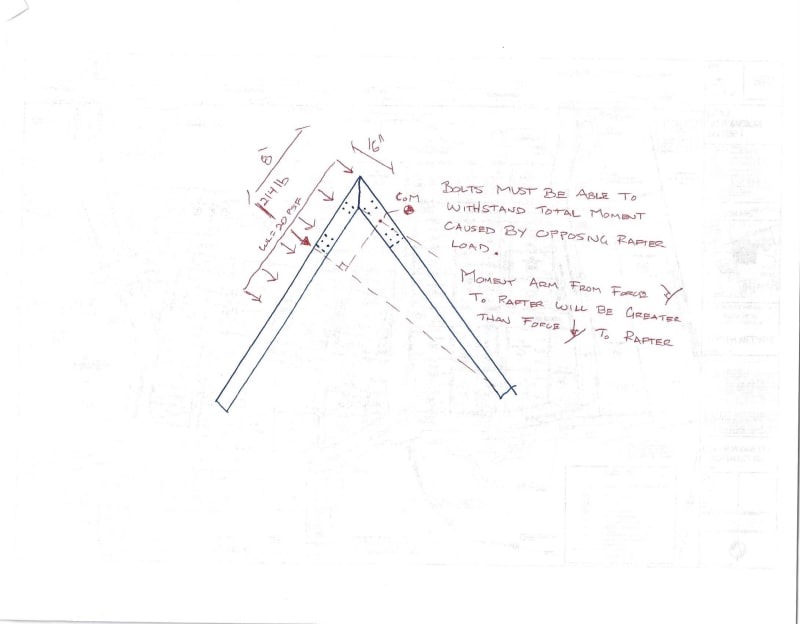the Paper Owl
Structural
- Sep 22, 2021
- 22
Good Morning Everyone,
After a client meeting, it has been decided to 'open up' a space a bit more and utilize a vaulted ceiling for an area of the structure that does not have a continuous floor joist (rafter tie) and would not have a collar tie (conflicting with the ceiling desired).
I am in the process of detailing a bent beam for a small span of rafters that do not have floor joists (the area of the loft where the staircase is located / open to the first floor below) and would like to avoid the use of sandwiching steel in between the double rafter (proper flinch beam). I instead would like to rely on the strength of through bolts to satisfy the situation.
It is my understanding that by using a bent beam at ridge, the controlling factors in design are the moments that are created. The first moment that needs to be satisfied is from the rafters desire to be pushed into the interior of the house (primarily from the wind and snow load) at a fulcrum that would be the midpoint of the rafter. The bolt configuration (utilizing NDS Chapter 12) would then need to act together to satisfy this moment.
The second moment that is created is from the rafters desire to thrust away from the ridge. With the ridge acting as a rigid connection and routing the load path of thrust to be that at the connection of the wall, a combination of the connection at the wall as well as the rigidity of the bent beam (bolts strength in moment capacity) will resist the thrust. I have attached drawings for this situation.
My questions are as follows:
- In calculation for the first moment, I do not agree with the idea to run the total point load (from the wind pressure loading of the rafter) along a straight line (that is perpendicular to the rafter being loaded) until it intersects the adjacent rafter. This proves for a rather large moment arm that creates a moment that 'does not pass the sniff test' in regards to how large it is for the scenario.
- In practice, is it common to design the bent beam to withstand a large amount of the thrust now apparent from the lack of any rafter / collar tie, in lieu of detailing the connection for the rafter to the wall?
Thank you in advance for any help in the matter.


After a client meeting, it has been decided to 'open up' a space a bit more and utilize a vaulted ceiling for an area of the structure that does not have a continuous floor joist (rafter tie) and would not have a collar tie (conflicting with the ceiling desired).
I am in the process of detailing a bent beam for a small span of rafters that do not have floor joists (the area of the loft where the staircase is located / open to the first floor below) and would like to avoid the use of sandwiching steel in between the double rafter (proper flinch beam). I instead would like to rely on the strength of through bolts to satisfy the situation.
It is my understanding that by using a bent beam at ridge, the controlling factors in design are the moments that are created. The first moment that needs to be satisfied is from the rafters desire to be pushed into the interior of the house (primarily from the wind and snow load) at a fulcrum that would be the midpoint of the rafter. The bolt configuration (utilizing NDS Chapter 12) would then need to act together to satisfy this moment.
The second moment that is created is from the rafters desire to thrust away from the ridge. With the ridge acting as a rigid connection and routing the load path of thrust to be that at the connection of the wall, a combination of the connection at the wall as well as the rigidity of the bent beam (bolts strength in moment capacity) will resist the thrust. I have attached drawings for this situation.
My questions are as follows:
- In calculation for the first moment, I do not agree with the idea to run the total point load (from the wind pressure loading of the rafter) along a straight line (that is perpendicular to the rafter being loaded) until it intersects the adjacent rafter. This proves for a rather large moment arm that creates a moment that 'does not pass the sniff test' in regards to how large it is for the scenario.
- In practice, is it common to design the bent beam to withstand a large amount of the thrust now apparent from the lack of any rafter / collar tie, in lieu of detailing the connection for the rafter to the wall?
Thank you in advance for any help in the matter.


